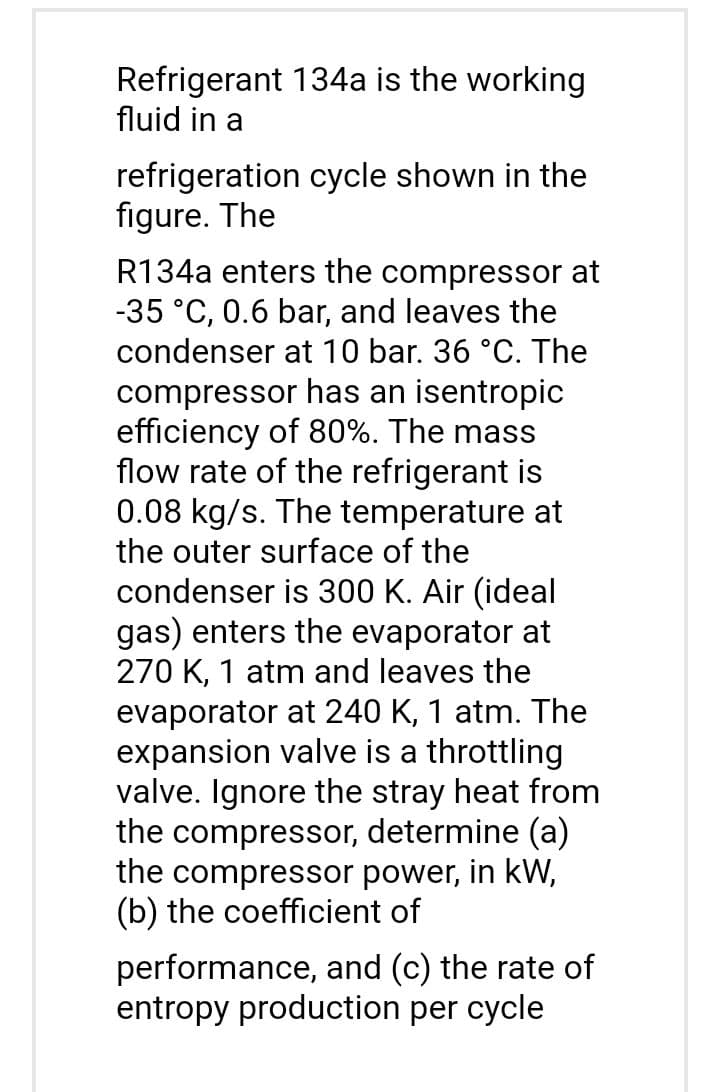Refrigerant 134a is the working fluid in a refrigeration cycle shown in the figure. The R134a enters the compressor at -35 °C, 0.6 bar, and leaves the condenser at 10 bar. 36 °C. The compressor has an isentropic efficiency of 80%. The mass flow rate of the refrigerant is 0.08 kg/s. The temperature at the outer surface of the condenser is 300 K. Air (ideal gas) enters the evaporator at 270 K, 1 atm and leaves the evaporator at 240 K, 1 atm. The expansion valve is a throttling valve. Ignore the stray heat from the compressor, determine (a) the compressor power, in kW, (b) the coefficient of performance, and (c) the rate of entropy production per cycle
Refrigerant 134a is the working fluid in a refrigeration cycle shown in the figure. The R134a enters the compressor at -35 °C, 0.6 bar, and leaves the condenser at 10 bar. 36 °C. The compressor has an isentropic efficiency of 80%. The mass flow rate of the refrigerant is 0.08 kg/s. The temperature at the outer surface of the condenser is 300 K. Air (ideal gas) enters the evaporator at 270 K, 1 atm and leaves the evaporator at 240 K, 1 atm. The expansion valve is a throttling valve. Ignore the stray heat from the compressor, determine (a) the compressor power, in kW, (b) the coefficient of performance, and (c) the rate of entropy production per cycle
Refrigeration and Air Conditioning Technology (MindTap Course List)
8th Edition
ISBN:9781305578296
Author:John Tomczyk, Eugene Silberstein, Bill Whitman, Bill Johnson
Publisher:John Tomczyk, Eugene Silberstein, Bill Whitman, Bill Johnson
Chapter28: Special Refrigeration Applications
Section: Chapter Questions
Problem 15RQ: Why is two-stage compression popular for extra-low-temperature refrigeration systems?
Related questions
Question
3

Transcribed Image Text:Refrigerant 134a is the working
fluid in a
refrigeration cycle shown in the
figure. The
R134a enters the compressor at
-35 °C, 0.6 bar, and leaves the
condenser at 10 bar. 36 °C. The
compressor has an isentropic
efficiency of 80%. The mass
flow rate of the refrigerant is
0.08 kg/s. The temperature at
the outer surface of the
condenser is 300 K. Air (ideal
gas) enters the evaporator at
270 K, 1 atm and leaves the
evaporator at 240 K, 1 atm. The
expansion valve is a throttling
valve. Ignore the stray heat from
the compressor, determine (a)
the compressor power, in kW,
(b) the coefficient of
performance, and (c) the rate of
entropy production per cycle
Expert Solution
This question has been solved!
Explore an expertly crafted, step-by-step solution for a thorough understanding of key concepts.
This is a popular solution!
Trending now
This is a popular solution!
Step by step
Solved in 7 steps with 2 images

Knowledge Booster
Learn more about
Need a deep-dive on the concept behind this application? Look no further. Learn more about this topic, mechanical-engineering and related others by exploring similar questions and additional content below.Recommended textbooks for you

Refrigeration and Air Conditioning Technology (Mi…
Mechanical Engineering
ISBN:
9781305578296
Author:
John Tomczyk, Eugene Silberstein, Bill Whitman, Bill Johnson
Publisher:
Cengage Learning

Refrigeration and Air Conditioning Technology (Mi…
Mechanical Engineering
ISBN:
9781305578296
Author:
John Tomczyk, Eugene Silberstein, Bill Whitman, Bill Johnson
Publisher:
Cengage Learning